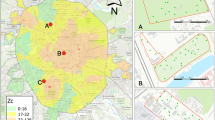Abstract
To control outdoor exposure to natural radiation, assessment of activity concentrations of the radionuclides in soils is substantial. In this paper, the activity concentration of natural radionuclides (226Ra, 232Th, 40K) was estimated for 174 agriculture soil samples using a sodium iodide detector (NaI) of (3” × 3”). Soil samples were collected from seven regions (56 locations) in EL-Minya governorate, Upper Egypt. The variability of natural activity concentration with soil’s textures was checked. The texture types of soil samples were silt clay loam, clay loam, sandy clay loam, and sandy silt loam. The obtained results indicate that the mean values of specific activity ranged from 11.3 ± 0.5 (sandy silt loam) to 21 ± 1(silt clay loam), 6.8 ± 0.3 (sandy silt loam) to 13.7 ± 0.7 (sandy clay loam), and 112 ± 5 (sandy silt loam) to 272 ± 13.6 (sandy clay loam) Bq kg−1 for 226Ra, 232Th, and 40 K, respectively. The obtained results were compared with the global average and tolerable limits as recommended in UNSCEAR 2008. On the other side, the radiological hazard resulting from the total natural radioactivity in the studied soil samples was estimated by different approaches. The obtained values were within the recommended safety limit and do not pose significant radiation hazards.










Similar content being viewed by others
References
European Commission Radiation Protection. Brussels report 112. European Commission; 1999. Radiological protection principles concerning the natural radioactivity of building materials
IAEA (1989) International Atomic Energy Agency, TRS 295. Measurements of radionuclides in food and the environment, Vienna
IAEA-314 Strachnov V, Valkovic V, Zeisler R, Dekner R (1991) Report on the inter comparison run IAEA-314: 226Ra, Th and U in stream sediment. IAEA/AL/038, IAEA, Vienna
ICRP (1991) International Commission on Radiological Protection, Recommendations of the International Commission on Radiological Protection, ICRP Publication 60, Annals of the ICRP, 21, NI 1–3, Pergamon Press, Oxford
Issa SAM, Mostafa AMA, Lotfy AEM (2015) Radiological impacts of natural radioactivity in phosphate rocks from El-Sibaiya and Red Sea coast mines, Egypt. J Radioanal Nucl Chem 303:53–61. https://doi.org/10.1007/s10967-014-3312-x
Karatash M, Turhan S, Varinlioglu A, Yegingil Z (2016) Natural and fallout radioactivity levels and radiation hazard evaluation in soil samples. Environ Earth Sci 75:424
Mostafa AMA, Uosif MAM, Elsaman R, Moustafa E (2016) Transfer factors of radionuclides from soil to wheat grains. Int J Sci Eng Res 7(2):642–644
Myatt TA, Allen JG, Minegishi T, Mccarthy WB, Stewart JH, Macintosh DL, Mccarthy JF (2010) Assessing exposure to granite countertops-part 1: Radiation. J Exposure Sci Environ Epidemiol 20:273–280
Shams ISSA, Mohamed UOSIF, Reda ELSAMAN (2013) Gamma radioactivity measurements in Nile River sediment samples. Turkish J Eng Env Sci 37:109–122
Taskin H, Karavus M, Ay P, Topuzoglu A, Hindiroglu S, Karahan G (2009) Radionuclide concentrations in soil and lifetime cancer risk due to the gamma radioactivity in Kirklareli, Turkey. J Environ Radioact 100:49–53
UNSCEAR (2008) Sources and effects of ionizing radiation. United Nations Scientific Committee on the effects of atomic radiation. United Nations Publication, New York
Uosif MAM, Tammam M, Issa AMS, Elsaman R (2012) Naturally occurring radionuclides in sludge samples from some Egyptian drinking water purification stations. IJAST 42:69–82
Uosif MAM, Issa S, Zakaly HMH, Hashim M, Tamam M (2016) The status of natural radioactivity and heavy metals pollution on marine sediments Red Sea Coast, At Safaga, Egypt. J Nucl Phys Mater Sci Radiat Appl 3(2):191–222
Acknowledgements
This work was carried out using the nuclear analytical facilities in Physics department, Faculty of science, AL-Azhar University, Assiut, Egypt and the texture of the agricultural soil samples were performed using particle size distribution with pipette method in the Faculty of Agriculture-Land department, Al-Azhar University, Assiut, Egypt.
Author information
Authors and Affiliations
Corresponding author
Additional information
Publisher's Note
Springer Nature remains neutral with regard to jurisdictional claims in published maps and institutional affiliations.
Rights and permissions
About this article
Cite this article
Mostafa, A.M.A., Uosif, M.A.M., Elsaman, R. et al. The dependence of natural radioactivity levels and its radiological hazards on the texture of agricultural soil in Upper Egypt. Environ Earth Sci 79, 228 (2020). https://doi.org/10.1007/s12665-020-08946-z
Received:
Accepted:
Published:
DOI: https://doi.org/10.1007/s12665-020-08946-z




